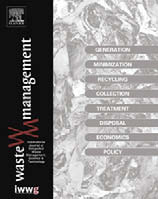1. Introduction
Micro-scale biomethanation (0.1–1.0 ton per day, tpd) is increasingly being tried as an alternative to mechanical and forced air composting when dealing with the organic fraction of municipal solid waste (OFMSW) and other wastes (Khandelwal and Mahdi, 1986) in small communities. Current waste management regulations permit conversion of OFMSW only through aerobic composting or biomethanation processes (MoEF, 2000; Ramachandra, 2006). As cities in developing countries grow, small extensions of the city area are created where residents attempt innovative solid waste management (SWM) approaches. In all such cases it is seen that finding suitable techniques at affordable costs for daily collection, transport, and processing of the OFMSW is the major hurdle (Joseph, 2006; Rathi, 2006; Ambulkar and Shekdar, 2004). While many innovations and options have been tried with respect to daily collection mechanisms and related equipment, there have been few options for decentralized stabilization of OFMSW. Biomethanation at a small scale is an ideal option as it minimizes transport costs and provides on-site treatment without aesthetic and sanitation issues (Kurup, 2003; Kale, 2004; Chanakya and Jagadish, 1997; Kalia and Kanwar, 1995).
Under decentralized conditions, the composition and quantity of the OFMSW collected can be highly skewed (Chanakya et al., 1997,2007a,b). Thus, the challenge at the lower (small) end of this scale is the ability to handle large variations in the composition and characteristics of wastes that are received and fed to biomethanation plants on a daily basis. Waste composition varies widely, ranging from predominantly dry leaves (difficult to decompose) to predominantly vegetable wastes or fruit peels, where fermentation is already initiated (Sateesh Kumar et al., 2001). In large biomethanation plants, such variations either even out or are easily managed by process control facilities. In decentralized small plants, rapid changes in the composition of OFMSW as indicated above will rapidly change the volatile fatty acids (VFA) generation pattern. A great deal of VFA overproduction can lead to an accumulation of inhibitory concentrations of VFA, hindering methanogenesis and sometimes even causing a drop in the pH level (Chanakya and Jagadish, 1997; Kurup, 2003; Kale, 2004).
Zhang and Zhang (1999) studied the anaerobic phased solids digester system for the conversion of rice straw to biogas. Lignocellulosic rice straw is difficult to degrade biologically. Hence, different pre-treatment methods such as physical, thermal, and chemical treatment on the digestion of rice straw were investigated. Results reveal that these chemical and mechanical pre-treatments significantly affected the digestibility of the straw. Lawn grass (a major fraction of MSW) was chosen and subjected to this digestion (Yu et al., 2002). The digester employed in this study was an 8 m3 solid phase reactor (harboring 155 kg of feedstock) coupled with a methane phase reactor consisting of inert commercial packing media used to facilitate bacterial attachment and growth. The maximum loading rate in this upflow anaerobic filter (UAF) was determined to be 2.7 kg of COD/m3 per day.
Biomass-fed plug-flow biogas reactors (PFBR) function like a three-zone fermentor wherein rapid decomposition occurs in the inlet zone, often with a clear VFA overproduction (acidogenic). In the second zone, after simple compounds in the biomass are removed, a balanced acidogenic–methanogenic decomposition occurs even when the biomass is in a floating state. There is a third VFA conversion zone in the digester liquid (Chanakya and Moletta, 2005). In the initial rapid acidogenesis stage, gas bubbles (CO2) generally nucleate around and adhere to the decomposing biomass particles, rendering them buoyant. The design and role of the inlet zone is to hold this buoyant, decomposing biomass under the digester liquid until most of the VFA flux from easily decomposed materials is removed and methanogens colonize on them (Jagadish et al., 1998; Chanakya and Moletta, 2005). Under normal circumstances, such buoyant biomass particles from the inlet zone soon form a floating mass that accumulates in size and rises above the liquid layer to gradually dry and become an unfermentable ‘‘scum”. The PFBR attempts to overcome this problem (Kurup, 2003). It places and retains the freshly fed biomass under the digester liquid for a period sufficient for the acidogenic bacteria to initiate decomposition and digest the easily decomposable fractions within the feedstock. As the decomposition rates fall and the slow-growing methanogenic bacteria colonize this biomass in sufficient numbers, the rate of acidogenesis and methanogenesis very quickly becomes balanced enough to conduct a stable and continuous fermentation of the biomass, even when the biomass feedstock begins to float (Chanakya and Moletta, 2005). This design and process modification avoids the energy- and capital-intensive chemical and physical pre-treatment (mentioned above), thereby making small decentralized fermenters viable. In such a scheme of events, it is important to determine the required period of fermentation wherein the rate of acidogenesis matches the potential of the methanogenic flora to capture acetate, to capture H2, and to reduce CO2 to methane. Various feedstocks have differing rates at which they achieve this balance between acidogenesis and methanogenesis (Chanakya et al., 1999). When digesting organic fractions of OFMSW are converted to biogas without the accumulation of toxic levels of intermediate VFA in the digester, an equilibrium between acidogens and methanogens is achieved. Obviously, at this stage the gas composition will be ideal, and the methane content will be much higher than CO2. When designing PFBRs for OFMSW, it thus becomes important to characterize the individual feedstocks to determine the threshold time required for such pre-digestion. In small-scale decentralized plants, in the absence of process control, it becomes important to determine from the individual feedstock’s VFA production or initial decomposition pattern how best the individual components can be co-fermented in appropriate blends such that VFA overproduction from one source could be compensated by a more stable cellulose lignin matrix of more lignified constituents. In this study, we attempt to collect data and examine such possibilities. The main objective of this study is to verify the previous hypothesis – that in plug-flow biogas reactor conditions there is a very rapid acidogenesis and total solids (TS)/volatile solids (VS) loss that makes the remaining mass amenable to fermentation even under conditions when the feedstocks remain afloat on the digester liquid (Jagadish et al., 1998; Chanakya and Moletta, 2005) – as well as to determine the duration and extent of decomposition that commonMSWfeedstocks need to undergo, and their corresponding holding time in this zone.
| E-mail | Sahyadri | ENVIS | Energy | GRASS | CES | IISc | E-mail |



